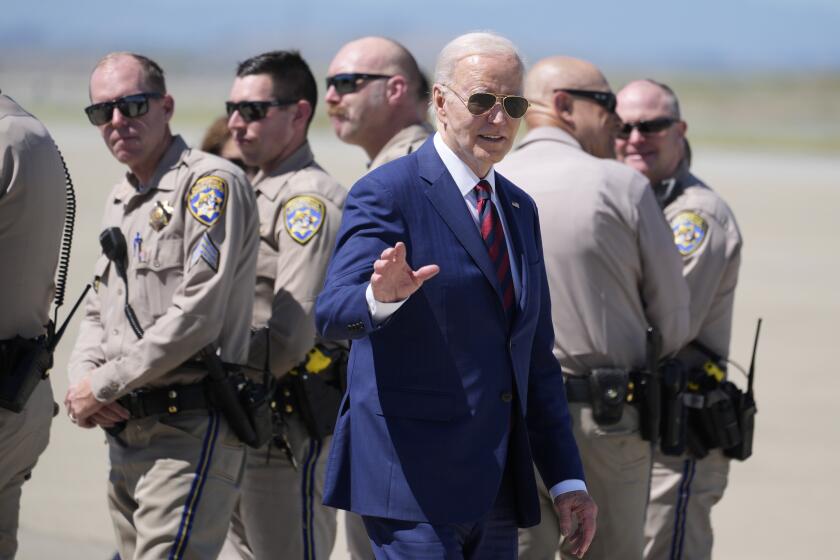Water Dilemmas : Regulations: A staff report by officials indicates that the state is satisfied with existing runoff guidelines assigned to L.A. County. Environmentalists had pushed for stricter controls.
An effort to strengthen controls on polluted storm water runoff in cities across Los Angeles County was dealt a serious setback last week when state water quality officials suggested that existing regulations are tough enough.
In a report to the State Water Resources Control Board, water quality officials recommended that the panel deny a request for stricter controls filed last summer by an environmental group. The board is scheduled to discuss the matter Thursday at a hearing in Sacramento.
The Natural Resources Defense Council, which monitors clean water regulations nationwide, asked the state board to overturn a permit issued last June to Los Angeles County and 16 local cities by the Regional Water Quality Control Board.
The permit, the first of its kind in California, requires local governments to begin cleaning up polluted storm water over the next five years. During the next two years, the effort will be expanded to include all 88 cities countywide.
The environmental group alleges that the permit does not go far enough to reduce polluted runoff and has little enforcement authority. The group charges that the permit violates the federal Clean Water Act--which sets criteria for regulating runoff--by failing to impose specific limits on pollutants in storm water discharges.
“The permit is a step in the right direction. The question is how big of a step to take,” said Joel Reynolds, a senior attorney for the Natural Resources Defense Council in Los Angeles. “We believe the Clean Water Act requires a stronger response.”
In its report to the state board, however, the board’s staff disputed the environmental group’s claims, concluding that the permit was “appropriate and proper.” The staff rejected the call for specific limits on pollutants, saying that they would be too expensive and difficult to enforce.
“This permit does truly represent a massive undertaking,” the staff wrote in its recommendation. “No other permit in the state, and perhaps the nation, will control the number of outfalls in a metropolitan areas as this permit undertakes to regulate.”
Thousands of miles of storm drains lie beneath the streets of Los Angeles County--a landmass covering 4,000 square miles--collecting billions of gallons of contaminated runoff annually and ultimately dumping it into the Santa Monica and San Pedro bays.
A study by the Natural Resources Defense Council estimates that 8 inches of rain in 1989 washed 150,000 pounds of lead, 500,000 pounds of zinc and 11,000 pounds of cadmium into Santa Monica Bay. The levels of the toxic heavy metals were far greater than those discharged by local sewage treatment plants during the same year, according to the study.
After years of delays and inaction, the federal government moved last year to force cities throughout the country to develop programs to cut down on contaminants in storm water. For cities in Los Angeles County, the federal crackdown led to the unprecedented agreement with the Regional Water Quality Control Board.
The five-year permit requires the participating cities to submit information to the state during the first year about storm water quality, rainfall amounts and development patterns to determine the sources of storm water pollution. In the second year, the county and cities must submit their plans to monitor storm water discharges and come up with a timetable to clean up the pollution and stop the illegal discharges.
In the third year, local governments must show that they have followed through on their cleanup plans and have begun to implement specific programs, which could range from stepped-up cleaning of catch basins on storm drains to public education about pollutants contained in fertilizers and pesticides.
Several city and county officials are expected to testify Thursday in Sacramento in support of the permit. Representatives from the Natural Resources Defense Council are expected to attend also.
“If our permit is overthrown, we will have to start all over again from ground zero,” said John Mitchell, who heads the county’s water-quality section, which coordinates storm water cleanup among cities in the county. “But my best guess is the board will do primarily what the staff says.”
Reynolds said he holds little hope that the state board will vote against the staff recommendation. He predicted that the issue will ultimately be resolved in court.
“We just don’t think the permit itself is strong enough,” he said. “There is no question but that a court is going to have to resolve the underlying legal issue.”
A spokeswoman for the state board said the panel would also consider a similar case Thursday involving a challenge to a storm water discharge permit issued to the Santa Clara Valley Water District in Northern California. The staff has also recommended that the board reject that claim.
More to Read
Start your day right
Sign up for Essential California for news, features and recommendations from the L.A. Times and beyond in your inbox six days a week.
You may occasionally receive promotional content from the Los Angeles Times.






